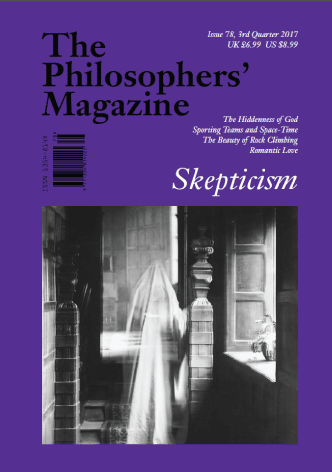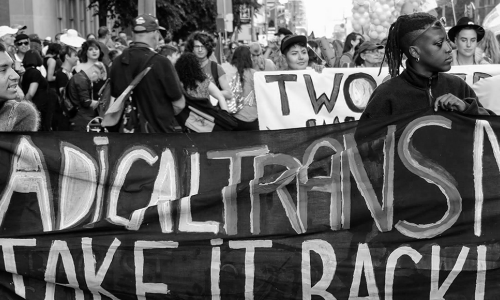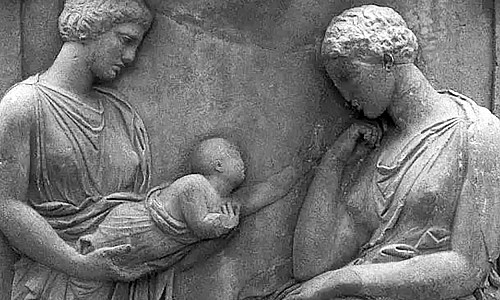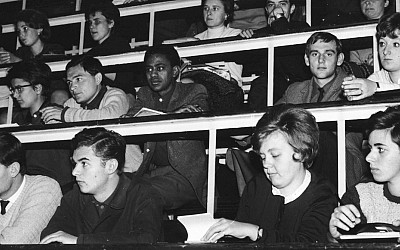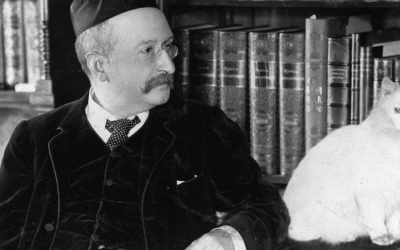Jennifer Saul on the psychological biases adversely affecting philosophy – and what we can do about it.
In the UK, women are 46% of undergraduate students in philosophy, but only 24% of permanent staff. Women are approximately 21% of professional philosophers in the US, but only 17% of those employed full-time. These figures are very unlike those for most fields of the humanities, in which women tend to be near or above parity with men. Indeed, they more closely resemble mathematics and physical sciences (biological sciences are much closer to parity). One recent study by Kieran Healy showed philosophy to be more male than mathematics, with only computer science, physics and engineering showing lower percentages of women.
What’s the explanation for this? It used to be thought that women were simply unsuited to philosophy. As Hegel puts it: “Women can, of course, be educated, but their minds are not adapted to the higher sciences, philosophy, or certain of the arts …. The difference between man and woman is the same as between animal and plant.”
This view is, for obvious reasons, less popular now. However, quite a few people, both feminist philosophers and philosophers of psychology, have drawn on the importantly distinct idea that women approach things differently, and that philosophy is the poorer for not fitting well with women’s ways of thinking. One version of this idea can be found in Carol Gilligan and another in very recent work by Wesley Buckwalter and Steve Stich. These claims of women’s difference, however, have never held up well empirically, as Louise Antony argues eloquently in her “Different Voices or Perfect Storm”.
Another commonly floated explanation is that women’s family commitments make it more difficult for them to progress professionally. This may well be true (studies do show that women continue to do the majority of housework and childcare). But it fails to explain why philosophy should show such a different profile than other fields of the arts and humanities, which have achieved (or surpassed) parity. If anything, one would expect it to be easier to thrive as a mother and philosopher than as a mother and scholar of French literature, who is far more likely to need to travel to archives and the like.
I am firmly convinced that there are multiple factors involved in causing the under-representation of women, factors that interact with and compound each other. One important one is the likelihood that women in philosophy experience an unusually high level of sexual harassment. It is very hard to get good data, comparative or otherwise on prevalence of sexual harassment due to very low rates of official reporting. However, many have been shocked by the stories reported at What is it Like to Be a Woman in Philosophy (beingawomaninphilosophy.wordpress.com). As the editor of this blog, I have been even more shocked by the large number of cases I have been contacted about which never appeared on the blog due to fear of identification.
Here, however, my main focus will be on implicit bias and stereotype threat, two well-established psychological phenomena. In the cases of implicit bias most relevant to this topic, people are found to hold unconscious biases against members of those groups that are negatively stigmatised in their culture. The biases take the form of, for example, a tendency to associate men rather than women more strongly with leadership. These biases are extremely widespread, and found both in members of the stigmatised groups and in those who are consciously highly egalitarian. Importantly, these biases are also very likely to be part of the explanation for the under-representation of other groups as well. We lack good data on the racial, class, sexual orientation or disability makeup of philosophy, but surely it is difficult to doubt that philosophy is overwhelmingly white, middle class, straight and non-disabled (and to a far greater degree, in fact, than it is male). These issues will not be my focus here, but it bears remembering that part of the reason there is so much discussion of women in philosophy these days is that there are now enough women in prominent positions to put this topic on the agenda. This is less so for other groups.
The implicit biases of philosophers have not yet been studied (although I’m working on it). However, there are widespread unconscious biases in our culture which bring it about that the same CV is considered less strong with a typically female or black name at the top of it, and that (for example) women having trouble being taken seriously as leaders. Women are also likely to receive weaker letters of reference and, when not marked anonymously, lower marks.
Now on to stereotype threat. This manifests itself when members of a group that is negatively stigmatised at some task are made aware of their group membership in a high stakes situation where they care about doing well. In such situations, we see underperformance from groups as diverse as white men at Princeton doing sports, girls doing mathematics and black students engaging in a test of academic ability. The reminder of group membership can come from many sources – ticking a box indicating gender, engaging in a stereotyped task (colouring in a picture of a girl holding a doll, for example) or simply being one of very few women in the room. When this happens, people who normally perform just as well as those from positively stereotyped groups see their performance decline precipitously.
Although we don’t yet have studies of philosophers, there is good reason to suppose that both implicit biases and stereotype threat play a role in perpetuating the under-representation of women in the field. In addition to biases against women that are widespread in the culture, it seems likely that philosophy as a field is stereotyped as male. Feminist philosophers have argued this point for decades (as in Sally Haslanger’s landmark “Changing the Ideology and Culture of Philosophy”). But it’s frankly what one would expect in a field that is nearly 80% male – it would be very surprising, given these demographics, if philosophy wasn’t associated with maleness. Add to this the fact that philosophy makes heavy use of logic (often requiring it for an undergraduate degree) and the well-established fact that mathematics is stereotyped, quite strongly, as male.
If this is right, then it’s very likely that women face a lot of barriers due to implicit bias. Their work is likely to be taken less seriously at every stage if not dealt with anonymously – from early student comments in discussions to work being marked and submitted for publication. (Although most refereeing in philosophy is anonymous, very little editing is and editors reject up to 65% of submissions without sending them to referees.) And these biases will continue to work against them as they apply for jobs, tenure and promotion. It bears emphasising that these biases will cause all sorts of people to fail to appreciate the quality of womens’ work – of all genders and political persuasions, including even those who are actively fighting for equality.
Stereotype threat will also cause women in philosophy to underperform. It will be regularly triggered – by exclusively or nearly exclusively male reading lists, overwhelmingly male lecturers, department seminar speakers and conference programmes. As they progress further in their careers, their colleagues will become increasingly male as well. Combine this with implicit biases, and it is not at all surprising that those who are not white males should have difficulty flourishing in philosophy.
The bright spot in all of this is that we can rather readily do something about it – both as a profession and as individuals. The first step, though, is to move away from a widely-held picture of biases. On this conception, things like sexism and racism are a matter of conscious beliefs, easily introspectable. This is a reassuring picture, as most of us well-meaning people can introspect and see that we don’t have any of those nasty racist and sexist beliefs. Having done due diligence in this way, we can trust ourselves to assess work, students and job candidates fairly. What we know about implicit biases shows this to be wrong. We are all likely to hold biases of which we are unaware, and we are likely to be similarly unaware of the ways that these biases are affecting our judgements in particular cases. Once we acknowledge this, we can begin to do something about it.
Whether or not we’re blameworthy for our implicit biases or their effects is a matter of considerable debate. (My own view is that in many cases we are not.)
But it is very clear that once we know about implicit biases, we acquire an obligation to try to do something about them. And philosophy will be far better off for our doing so: as things stand now, we are very likely assessing work unfairly at all levels unless we’ve anonymised. This means people are not getting the marks they deserve, and we’re not selecting the right papers for publication. We’re also likely to fail to hire the best candidates. Stereotype threat is very likely to be causing some of the most talented women to underperform. The quality of work being published in philosophy, then, is lower than it otherwise would be – both due to actual underperformance and due to unconscious biases affecting assessment at all stages. Both for the sake of fairness and for the sake of philosophy, then, one should want to do something.
And there is a lot we can do, both as a profession and as individuals. The most obvious step is to anonymise whatever we can. Anonymised marking is nearly universal in the UK, but almost unheard of in the US. (For any Americans reading this, anonymity can easily be accomplished by having all students put their name only on cover sheets. Before you start grading, fold all cover sheets back. Don’t look at them again until you’re done grading. Anoymised refereeing is widespread but anonymous editing isn’t – and it’s increasingly straightforward to implement as more journals move to electronic submission.
But anonymity is not always feasible, and anyway it would do nothing for stereotype threat. To address these problems at their source, we need to change the stereotypes. The best way to do this is to expose people to what are known as “counter-stereotypical exemplars”, well-known people who fail to perform to the stereotypes of their stigmatised groups. Even brief exposure can be effective in blocking the operation of implicit biases – gazing at a picture of Martin Luther King for a few minutes before taking a race Implicit Association Test dramatically alters performance. But obviously the more exposure the better. That’s why it’s such a good idea to try to avoid all-male conferences and edited volumes. We should also try to put women on our syllabi, and also to hire them and get them as PhD students. All this, however, is easier said than done.
The most basic thing for accomplishing all of these goals is to begin with a bit of distrust for our initial judgements. For example, the first names that leap to mind for a syllabus or conference are likely to be men, whether or not they are actually the best people to have. Spending a bit of time trying to think of some women who work on the topic will in all likelihood lead to the inclusion of some excellent people one might not otherwise have thought of. (It’s worth recalling also that prominence in the field will be partly a function of biases –there are very likely plenty of women who deserve to be prominent but are not so.)
Our initial judgements of job candidates are likely to be influenced by their gender. There are many ways we can try to counteract this. A key one is to make sure that we never fall back on a simple feeling of fit, but instead examine and discuss our judgements carefully. Another is to make sure we agree upon multiple data points and their relative priority in advance – studies have shown that judgements of the importance of criteria can switch in some worrying ways (credentials most important if they’re what the male candidate has, work experience more important if that’s his stronger suit). Multiple data points will also help correct for individual bits that may have been affected by stereotype threat: a job talk to an overwhelmingly male audience may not be as accurate a measure of a woman’s abilities as a writing sample, for example.
My final suggestion may actually be the most difficult to implement: it’s to stop talking about “who’s smart”, a widespread vice of philosophers in my experience. As Eric Schwitzgebel notes, these sweeping judgements are really very problematic: “I have been collecting anecdotal data on seeming smart. One thing I've noticed is what sort of person tends spontaneously to be described, in my presence, as ‘seeming smart’. A very striking pattern emerges: In every case I have noted the smart-seeming person has been a young white male …. Seeming smart is probably to a large extent about activating people's associations with intelligence. This is probably especially true when one is overhearing a comment about a complex subject that isn't exactly in one's expertise, so that the quality of the comment is hard to evaluate. And what do people associate with intelligence? Some things that are good: poise, confidence (but not defensiveness), giving a moderate amount of detail but not too much, providing some frame and jargon, etc. But also, unfortunately, I suspect: whiteness, maleness, a certain physical bearing, a certain dialect (one American type, one British type), certain patterns of prosody –all of which favor, I suspect, upper- to upper-middle class white men.”
Smartness claims are also remarkably immune to counter-evidence (“He’s smart, he just doesn’t work very hard”; “She’s not really smart, she just works very hard”). Moreover, smartness judgements are deeply tied to the notion that there is such a thing as smartness, of which some people are lucky enough to have a big dose while the unlucky get less. And this view of intelligence, Carol Dweck has shown, makes it easier for stereotype threat and implicit bias to do their nasty work. Teaching people instead that intelligence is malleable and can be increased through effort helps to insulate against both phenomena. It also helps to motivate people to seek out challenges and to work hard.
In short, there is much that we can all do to fight the implicit biases and stereotype threat that are very likely impeding the process of women (and other groups) in philosophy. My view is that we should all start doing these things whenever we can: they will increase fairness, and improve philosophy.
Further reading
The report authored by Jennifer Saul and Helen Beebee, with more detail on these biases as well as thoughts about what we can do to combat them is called, “Women in Philosophy in the UK”. It’s available at swipuk.org/notices/2011-09-08.
For the view from America, see Kathryn Norlock’s “Women in the Profession”, available at apaonlinecsw.org/workshops-and-summer-institutes.
Kieran Healy’s graph showing the percentage of PhDs awarded in the US to women by discipline, see kieranhealy.org/files/misc/phil-by-discipline.pdf.
For readings on implicit bias and stereotype threat, see biasproject.org/recommended-reading and reducingstereotypethreat.org. You can take the Implicit Association Test at Project Implicit implicit.harvard.edu/implicit.
For more on avoiding all-male conferences, see the Gendered Conference Campaign feministphilosophers.wordpress.com/gendered-conference-campaign.
Jennifer Saul is Professor and Head of Department at the University of Sheffield, Director of the Implicit Bias and Philosophy Research Network, and Director of SWIP UK. She is co-author with Helen Beebee of the BPA/SWIP report "Women In Philosophy in the UK" and author of Lying, Misleading And What Is Said.
You might also like...
